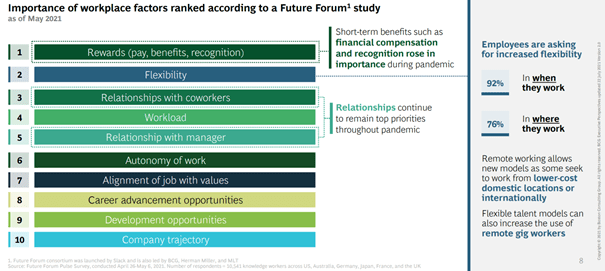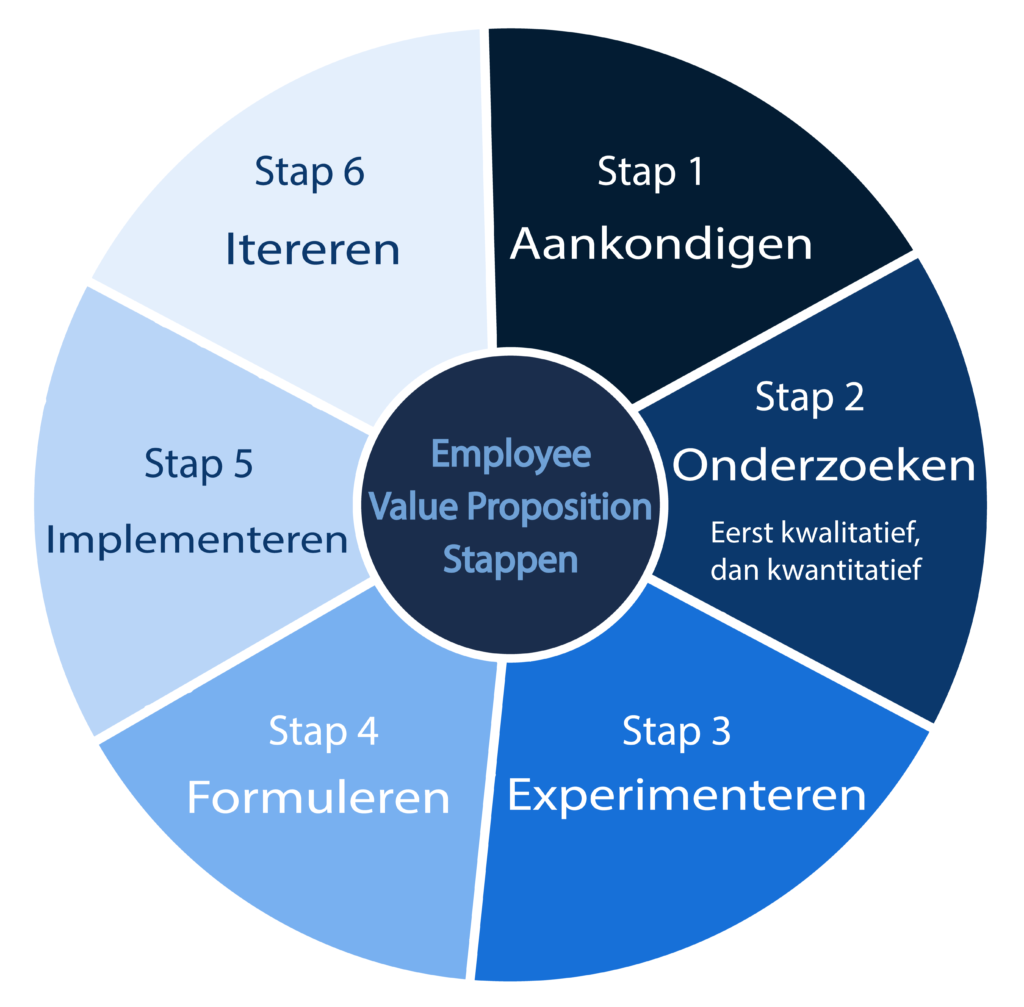The world is changing rapidly due to trends and developments such as COVID-19, climate change, the formation of power blocks, such as the United States and China, and increasing attention for diversity and inclusivity.

All of these changes affect how, where and when we work, who is available for work and where potential employees want to work.
Not everyone’s wishes will be the same though. Specific employee segments (e.g. according to level of education, life stage, industry or region) will have specific needs.

Given these developments and the variety in desires ensuing from these developments, it is crucial for organizations to invest in an Employee Value Proposition (EVP) that matches its target group(s) and to update this EVP from time to time in response to the latest developments.
Looking for more information? Contact us without obligations!
More information? Feel free to contact us!
Meaning of Employee Value Proposition (EVP)
An Employee Value Proposition (EVP) is a value proposition for employees. As such, it is about what an employer has to offer to its employees in exchange for their efforts. It creates value for all stakeholders, such as shareholders and clients.
‘Value creation’ often makes people think primarily in terms of monetary rewards such as salaries and profit-sharing schemes. However, non-monetary rewards are certainly part of it too. This may include cultural elements, such as autonomy, but also career opportunities or the ability to work from a location of choice. Thus, the total package of employment conditions is what counts.
How to achieve a good Employee Value Proposition (EVP)?
A study by Browne (2012) shows that organizations with effective EVPs benefit in various ways:
- Increased attractiveness: an effective EVP deepens the new talent pool in the labour market, in that an effective EVP also attracts passive job seekers / people who would not have become active otherwise. A good EVP also contributes to talent retention.
- Increased employee engagement: organizations with an effective EVP have a higher proportion of deeply committed employees.
- Reward cuts/optimization: Organizations with an effective EVP can lower their wage costs by concentrating on those reward elements that are important to employees, removing any reward elements that do not contribute to the proposition and/or shifting focus to reward elements that make the difference.
An effective EVP is developed together with your (potential) employees
An Employee Value Proposition only adds value when it is truly incorporated in the organization’s policies, processes and culture.
This is why AnalitiQs believes in an approach that actively involves (potential future) employees in creating the Employee Value Proposition (EVP).
If internal staff and potential future employees jointly create an Employee Value Proposition (EVP), there will be greater internal support once the new or adjusted Employee Value Proposition (EVP) is launched, and it will be embraced sooner and more wholeheartedly.
Co-creation also makes it easier to tweak the EVP to match specific talent segments (e.g. based on roles/positions, life stage or region). After all, working together leads to insights into the needs of each target group.
Six steps towards an impactful EVP
What does an Employee Value Proposition (EVP) co-creation process look like? According to a study by Avinash Pawar (2016), it takes six steps to implement an effective Employee Value Proposition (EVP):

1 – Announce – so as to stress the importance of the introduction of a new / adjusted EVP and to enthuse people to think along, it is important that the initiative is announced by upper management.
2 – Research – a good EVP seamlessly fits into the organization and its people strategy. A proper understanding of the overall strategy is therefore essential. This can be achieved through desk research and several interviews. Subsequently, it is necessary to map, through research, the bottle necks in the present EVP and the existing ideas to improve the EVP as well as to validate hypotheses and prioritize wishes. The creation of an EVP usually starts with qualitative research. This qualitative EVP is mainly used to identify the main opportunities and bottlenecks. Suitable instruments for qualitative research are interviews and focus groups. The qualitative part of the research is followed by quantitative research. During this phase, an EVP survey is sent to a broad(er) group of employees. This survey is tailored using the insights from the qualitative research.
3 – Experiment – where necessary, experimentation may be of added value. Is a four-day working week feasible, for example, and what are the benefits? Or are more flexible working hours indeed beneficial to the work-life balance? If an experiment shows that a particular EVP element indeed adds the assumed value, the element can be widely deployed.
4 – Formulate – the insights gained from EVP research and any experiments can be used to flesh out the new EVP. When drawing up the EVP, the following questions must carefully be kept in mind:
– Does it tie in with the strategic goals?
– Does it help the organization to differentiate itself?
– Does it present a realistic image?
– Does it inspire?
– Does it require any tweaks for specific target groups?
5. Implement – once the ideal EVP has crystallised, it is time to implement it, i.e. moving the concept from paper to practice using the relevant communication material.
6. Iterate – the world is not a static place, so the EVP will have to be tweaked from time to time. Sometimes, this will be a minor adjustment that is easy to make. At other times, however, it may require a full reiteration of the above steps. AnalitiQs uses ROI research and HR Dashboards to help organizations map the impact (i.e. business value) of a new/updated EVP.
AnalitiQs helps you to create an effective Employee Value Proposition (EVP)
AnalitiQs always places data and a structured approach at the heart of its working method. The needs of (potential future) employees are mapped through internal and external, qualitative and quantitative Employee Value Proposition (EVP) research. To this end, AnalitiQs uses its own labour-market panel. People Analytics techniques are subsequently deployed to determine employee segments and identify the preferences per segment. Based on these insights, recommendations are made towards an optimal Employee Value Proposition (EVP).
These insights and recommendations are then presented on an interactive, visual Employee Value Proposition (EVP) dashboard and/or in a management report. For the implementation of the Employee Value Proposition (EVP), AnalitiQs collaborates with the client’s internal HR / Change professionals or one of its partners.
Get a quotationInterested? Feel free to contact us!

Gido van Puijenbroek
Detailed Service Overview
HR Analysis
Equal Pay
Gender mobility
Absenteeism
Employee Segmentation
Employee Retention & Attrition
Engagement
Impact Measurement / ROI
Learning & Development
Management Development
Onboarding
Organisational Network
Performance
Process Mining
Productivity
Recruitment
Restructuring / Organizational-Development
Reward
Strategic Workforce Planning
Succession Management
Employee Surveys
Culture
Employee Satisfaction
Job Satisfaction
Inclusion
Onboarding
Employee Turnover
Diversity
Employee Community / Panel
Employee Engagement
Employee Commitment
Employee Journey
Employee Net Promotor Score (eNPS)
Employee Value Proposition (EVP)
Employee Enthusiasm
Labour Market
Labour Market Panel
Labour Market Positioning
Leadership
Manager Feedback
Personal Development
Pulse
Retention
Role Clarity
Sentiment
Strategic Alignment
Team Feedback
Total Reward Optimization
Voice of the Employee (VoE)
Work from home
Work Stress
Work Pressure
Capability Building
HR Analytics Strategy
HR Analytics Product Owner
HR Analytics Outsourcing
HR Academy
HR Dashboards
Absenteeism Dashboard
Integral HR Dashboard
Leadership Dashboard
Learning Dashboard
Recruitment Dashboard
Reward Dashboard
Talent Development Dashboard
